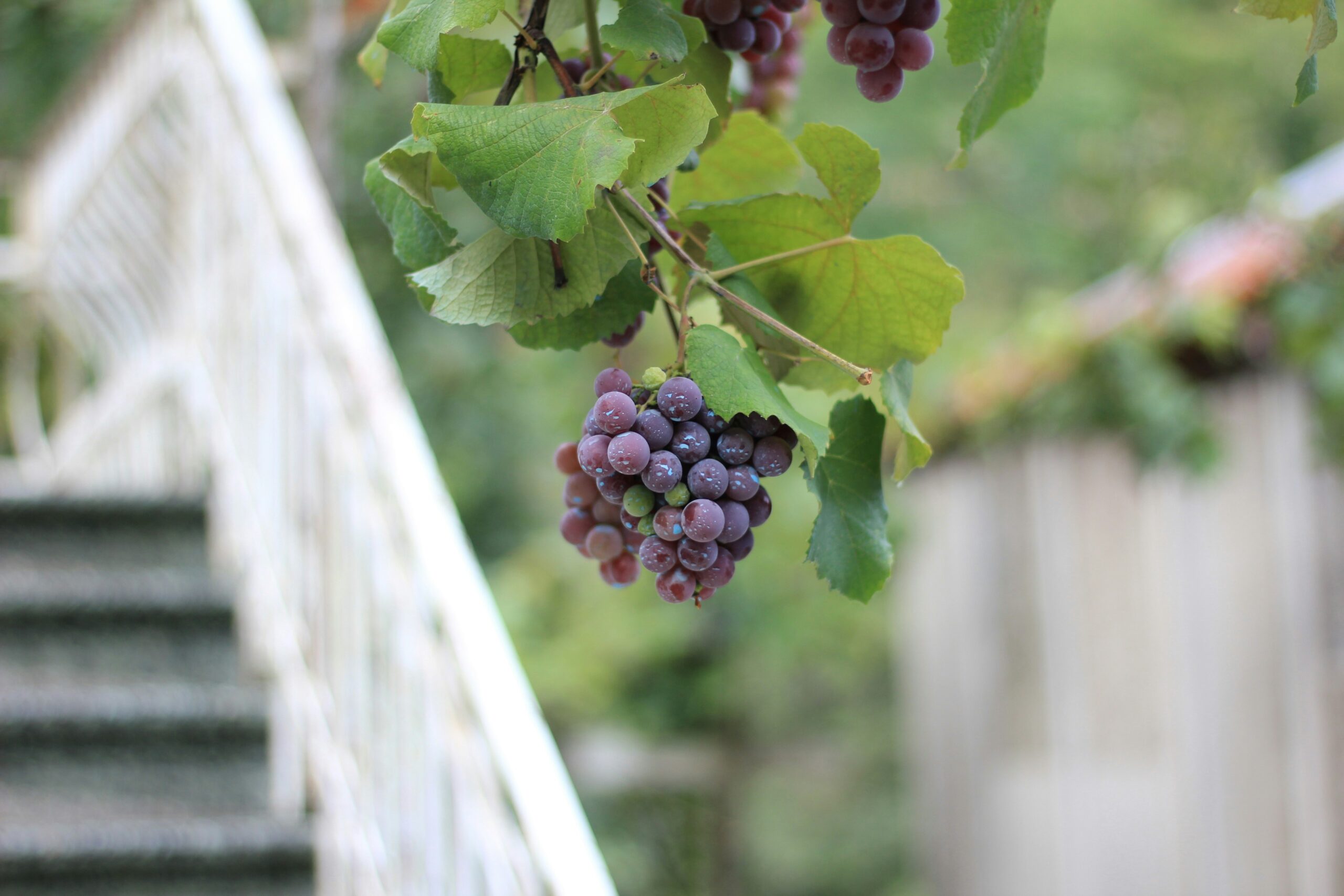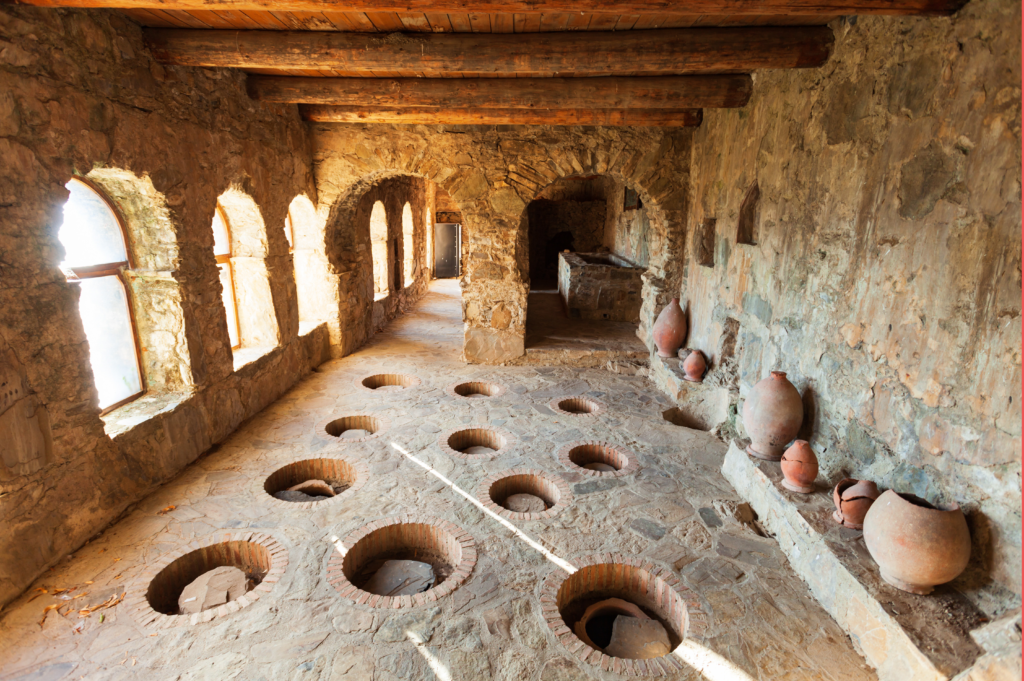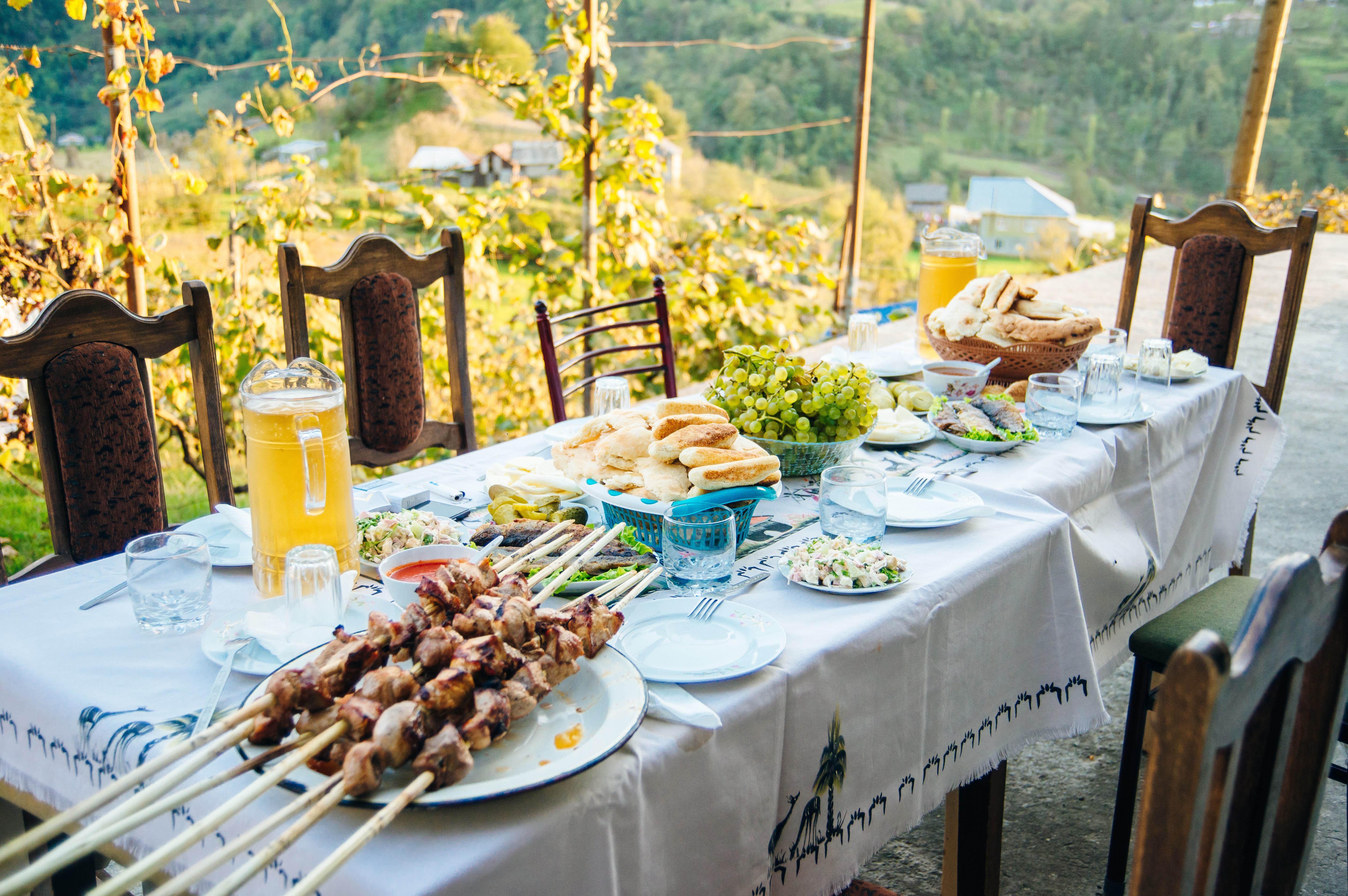
Georgia: The Birthplace of Wine
Georgia is known as the “Cradle of Wine”, a title that reflects its extraordinary history and deep cultural connection to viticulture. For over 8,000 years, this small Caucasus country has been producing wine, making it one of the oldest winemaking regions in the world. From its ancient methods of wine production, particularly the use of Qvevri (clay vessels), to its vast variety of native grape varieties, Georgian wine is more than just a drink; it’s an integral part of the nation’s identity, history, and heritage. This guide explores why wine culture is a compelling reason to visit Georgia and what makes the country a must-visit destination for wine lovers.
The Birthplace of Wine: 8,000 Years of Winemaking Tradition

Georgia’s claim as the “Cradle of Wine” is not just a marketing slogan; it is backed by archaeological evidence that dates the country’s winemaking tradition to at least 6,000 BCE. The discovery of ancient wine vessels and grape seeds in Georgia confirms that the region has been continuously producing wine for millennia. Wine here isn’t merely a product, but a symbol of hospitality, culture, and life itself.
a. Ancient Qvevri Winemaking
One of the most fascinating aspects of Georgian winemaking is the traditional method of using Qvevri, large clay pots that are buried underground for fermentation and storage. This method has been recognized by UNESCO as an Intangible Cultural Heritage of Humanity.
- How Qvevri Wine is Made: Grapes are pressed, and the juice, skins, stems, and seeds are poured into the Qvevri. The vessel is then sealed and buried for several months to allow natural fermentation. This unique process produces wines with robust flavors, rich textures, and distinctive character.
- UNESCO Recognition: The Qvevri tradition is central to Georgian winemaking, and it plays a key role in preserving ancient techniques that have been passed down through generations. For visitors, experiencing Qvevri wine is a chance to taste the past.
b. The Oldest Wine Artifacts
Archaeological finds in regions such as Kakheti and Kartli have uncovered clay jars containing remnants of wine that date back over 8,000 years, solidifying Georgia’s place as the world’s first winemaking country. These finds also demonstrate the significance of wine in Georgian daily life, rituals, and social customs from ancient times to today.
Georgia’s Diverse Wine Regions

Georgia is home to several distinct wine regions, each offering unique microclimates, grape varieties, and wine styles. Travelers can explore these regions through scenic wine tours, vineyard visits, and tastings at family-owned wineries, all while learning about the ancient techniques and modern innovations in Georgian winemaking.
a. Kakheti: The Heart of Georgian Wine
Kakheti, located in eastern Georgia, is the country’s most famous and productive wine region, often referred to as the “wine capital” of Georgia. It is a must-visit destination for any wine enthusiast.
- Sighnaghi: The town of Sighnaghi, known as the “City of Love,” is perched on a hilltop and offers stunning views of the Alazani Valley and the Caucasus Mountains. The town’s charm, combined with its proximity to wineries, makes it a great base for wine tours.
- Traditional Kakhetian Wines: Kakheti is renowned for its use of both ancient Qvevri methods and modern winemaking techniques. Visitors can sample red and white Qvevri wines like Rkatsiteli, Saperavi, and Kindzmarauli, all of which are indigenous to Georgia.
- Winery Tours: Many family-owned and boutique wineries, such as Pheasant’s Tears, Shumi, and Tsinandali, offer guided tours, tastings, and insights into both traditional and contemporary wine production methods.
b. Kartli: Where History and Wine Meet
Kartli, located in central Georgia, is another prominent wine region known for its historical significance and diverse grape varieties. The region produces both traditional Qvevri wines and European-style wines.
- Mtskheta and Jvari: The ancient city of Mtskheta and the Jvari Monastery, both UNESCO World Heritage Sites, are located in this region. Visitors can combine historical exploration with visits to nearby wineries.
- Gori and Uplistsikhe: In Gori, the birthplace of Stalin, you can also find the rock-hewn city of Uplistsikhe, which was once a key center for wine storage and trade in ancient Georgia. Many old wine cellars and Qvevri remnants can be found in this historical site.
- Notable Wines: Kartli is famous for both white and red wines made from varieties like Chinuri, Tavkveri, and Shavkapito.
c. Imereti: The Land of Unique Flavors
Imereti, located in western Georgia, offers a milder, more humid climate, which produces wines with different characteristics from those in the eastern regions. The wines here are often lighter and more aromatic.
- Kutaisi: The capital of Imereti, Kutaisi, is one of Georgia’s oldest cities and serves as a gateway to the region’s vineyards. The city’s ancient heritage, including UNESCO sites like Bagrati Cathedral and Gelati Monastery, makes it a cultural hub as well as a wine destination.
- Imeretian Qvevri Wines: While Imereti also uses the Qvevri method, their process involves less skin contact during fermentation, producing lighter, fresher wines. Notable grape varieties from Imereti include Tsolikouri, Krakhuna, and Otskhanuri Sapere.
d. Racha-Lechkhumi: Home of Semi-Sweet Delights
Racha-Lechkhumi, located in northwestern Georgia, is a small but significant wine region, particularly known for producing some of Georgia’s finest semi-sweet wines.
- Ambrolauri: This picturesque town in the foothills of the Greater Caucasus is the center of Racha’s wine production. The area’s unique terroir, combined with centuries-old winemaking traditions, results in exceptional wines.
- Khvanchkara Wine: The region is famous for Khvanchkara, a semi-sweet red wine made from Aleksandrouli and Mujuretuli grape varieties. It is one of Georgia’s most celebrated wines and has a distinct, rich flavor that wine enthusiasts will appreciate.
e. Adjara and Guria: Coastal Wine Regions
The subtropical regions of Adjara and Guria, located along the Black Sea coast, are lesser-known but emerging wine regions. These areas are known for their unique climate and grape varieties that differ from those found in the interior.
- Adjara: The coastal city of Batumi, with its seaside charm and modern appeal, is also a starting point for exploring the nearby vineyards. The region’s humid climate allows for the cultivation of rare grape varieties like Chkhaveri, which is used to produce light, fruity rosé wines.
Guria: Known for its rolling hills and subtropical climate, Guria is also experimenting with revitalizing ancient grape varieties, such as Jani and Chkhaveri, for wine production.
Unique Georgian Grape Varieties

One of the most compelling reasons to explore Georgia’s wine culture is the country’s incredible diversity of grape varieties. Georgia is home to over 500 indigenous grape varieties, offering an unparalleled range of flavors and styles. Some of the most well-known and unique varieties include:
a. Saperavi
Saperavi is Georgia’s most famous red grape variety, known for producing deep, dark, and tannic wines. It is used to make both dry and semi-sweet wines, with rich flavors of black fruits, spices, and earthy undertones.
b. Rkatsiteli
One of the oldest and most widely grown white grape varieties in Georgia, Rkatsiteli produces full-bodied wines with flavors of green apple, quince, and a distinct minerality. It is commonly used in Qvevri winemaking.
c. Chinuri
Grown primarily in the Kartli region, Chinuri is a white grape variety known for its fresh acidity and floral, citrusy notes. It is often used in sparkling wines and is prized for its light, crisp character.
d. Tsolikouri
Found mainly in western Georgia, Tsolikouri is a versatile white grape variety used to make both dry and semi-sweet wines. It produces wines with a delicate balance of acidity and sweetness, featuring notes of pear and melon.
Wine Tourism in Georgia: Experiences and Activities

Georgia’s wine tourism offers more than just wine tastings. The experience is deeply cultural and immersive, often involving home-cooked meals, traditional Georgian feasts (supra), and participation in grape harvesting and wine-making processes.
a. Wine Tasting and Vineyard Tours
Throughout Georgia, wineries of all sizes open their doors to visitors, offering guided tours of vineyards, cellars, and Qvevri workshops. Guests can sample a wide variety of wines while learning about the unique production methods.
- Wine Tours in Kakheti: The rolling hills of Kakheti are dotted with vineyards, and many wineries offer day-long or multi-day tours, complete with tastings, local cuisine, and overnight stays at wine estates.
- Harvest Festivals: The grape harvest season, known as Rtveli, is a major event in Georgia, particularly in the Kakheti region. Visitors can participate in this centuries-old tradition, helping to pick grapes and experiencing the full cycle of winemaking.
b. The Supra: A Traditional Georgian Feast
A visit to Georgia would be incomplete without experiencing a supra, the traditional Georgian feast that revolves around wine, food, and toasts led by a tamada (toastmaster). The supra is a celebration of life, friendship, and hospitality, and wine flows freely throughout the evening.
Wine Festivals and Events

Georgia hosts a number of annual wine festivals that attract both locals and international visitors. These events provide a great opportunity to sample wines from across the country and meet the winemakers themselves.
New Wine Festival: This springtime event celebrates the new vintage wines of the year, with a particular focus on small and family-owned producers.eritage.
Tbilisi Wine Festival: Held every autumn, this festival in the capital city features wines from all of Georgia’s major wine regions, along with live music, food stalls, and traditional crafts.
